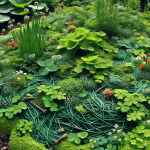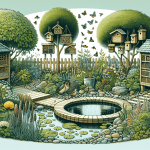This post may contain affiliate links. As an Amazon Associate, we may earn commissions from qualifying purchases.
Ready to transform your plain lawn into a flourishing garden bed? This article offers you step-by-step guidance on how to accomplish just that. From selecting the right location to enriching your soil and choosing the ideal plants, we’ve got you covered. Dive into the simple yet rewarding process of creating a garden bed that will bring life and color to your outdoor space.
How Can I Turn A Lawn Into A Garden Bed?
Have you ever looked at your lawn and thought, “Wouldn’t it be amazing to turn part of this into a lush garden bed?” If so, you’re not alone! Creating a beautiful garden bed from a patch of plain grass can be a rewarding project that brings a touch of nature’s splendor right to your doorstep.
How can I turn a lawn into a garden bed? Let’s dive into the nitty-gritty of transforming your backyard or front lawn into a blooming paradise.
Why Turn a Lawn into a Garden Bed?
Converting a section of your lawn into a garden bed brings numerous benefits. By doing so, you enhance the aesthetic appeal, biodiversity, and even increase your property’s value. Plus, you’ll enjoy fresh flowers, vegetables, and the satisfaction of nurturing plants from the ground up.
Benefits of a Garden Bed
| Benefit | Description |
|---|---|
| Aesthetic Appeal | A well-designed garden bed adds beauty and color, creating an eye-catching spot in your yard. |
| Biodiversity | Garden beds attract birds, butterflies, and beneficial insects, boosting local biodiversity. |
| Fresh Produce | Growing your own vegetables and herbs provides fresh, organic produce, reducing trips to the grocery store. |
| Mental Health | Gardening is a relaxing activity that can reduce stress and improve mental well-being. |
| Environment Friendly | Reduces lawn mowing, saving on fuel and reducing carbon emissions. |
Planning Your Garden Bed
Every successful garden bed begins with a solid plan. Before you dig in, let’s go through the key steps you need to consider to ensure your garden thrives.
Choosing the Right Spot
Selecting the right spot for your garden bed is crucial. Consider sunlight, soil conditions, and accessibility. Most vegetables and flowers require at least 6-8 hours of sunlight daily.
Measuring and Marking the Area
Measure the area you want to convert and mark it using strings and stakes. Having a clear boundary helps you visualize the space and makes the next steps more manageable.
Testing the Soil
Before you start digging, test your soil. You can purchase a soil test kit or send a sample to a local extension office. Knowing the pH level and nutrient content helps you adjust soil conditions for optimal plant growth.
Creating a Garden Plan
Sketch out your garden bed layout, including plant placement and any paths or borders. This helps you stay organized and anticipate space requirements for each plant.

Preparing the Lawn
The preparation process involves removing the grass and conditioning the soil to create a healthy growing environment for your plants.
Removing the Grass
There are several methods to remove grass. Choose one that matches your needs and preferences.
Manual Removal
Manual removal involves digging up the turf by hand. It’s labor-intensive but effective. Use a sharp spade or garden hoe to cut under the grass and lift it up.
Smothering with Mulch
An eco-friendly option is to smother the grass with a thick layer of organic mulch, such as cardboard, newspaper, or compost. This method requires patience as it can take several months for the grass to die off completely.
Solarization
Solarization involves covering the area with clear plastic to trap the sun’s heat, effectively “cooking” the grass and weed seeds. It works best in sunny, warm climates but takes several weeks to complete.
Conditioning the Soil
Once the grass is gone, it’s time to prepare the soil. Loosen it up to allow roots to penetrate easily and incorporate organic matter to boost fertility.
| Step | Description |
|---|---|
| Loosening the Soil | Use a garden fork or tiller to break up the soil to a depth of 8-12 inches. This improves drainage and root penetration. |
| Adding Compost | Mix in 2-3 inches of organic compost to enrich the soil with nutrients. Compost improves soil structure and provides a slow-release source of plant nutrients. |
| Adjusting pH | Based on your soil test results, you may need to adjust the pH by adding lime (to raise pH) or sulfur (to lower pH) to create an optimal growing environment. |
Designing Your Garden Bed
Here comes the fun part! Designing your garden bed allows you to unleash your creativity and plan a thriving garden that suits your style.
Plant Selection
Choose plants that suit your garden goals, whether it’s growing edible crops, flowers, or a mix of both. Consider factors like climate, soil type, and sunlight when selecting plants.
Popular Choices for Garden Beds
| Edible Plants | Ornamental Plants | Companion Plants |
|---|---|---|
| Tomatoes | Marigolds | Basil |
| Lettuce | Petunias | Chives |
| Carrots | Daisies | Nasturtiums |
| Peppers | Sunflowers | Borage |
Creating a Layout
A well-thought-out layout ensures your plants thrive and blends aesthetics with practical considerations like access and growth space.
Row Planting
Row planting is straightforward and easy to manage. It’s perfect for vegetable gardens where plants of the same type are grouped in rows.
Block Planting
Block planting involves arranging plants in small, square blocks. This method maximizes space and is great for intensive gardening.
Mixed Planting
Mix ornamental plants with edibles to create a visually appealing garden. Companion planting can also help deter pests and enhance growth.
Installing Borders
Borders define the edges of your garden bed and add a finishing touch. Choose from various materials like brick, stone, wood, or metal, based on your garden style.

Planting Your Garden Bed
After all that preparation, it’s finally time to plant! Whether you’re using seeds, seedlings, or transplants, proper planting techniques ensure your garden gets off to a strong start.
Planting Seeds
Follow the seed packet instructions for planting depth and spacing. Gently press the seeds into the soil and cover them with a thin layer of soil.
Transplanting Seedlings
If you’re starting with seedlings, dig holes slightly larger than the root ball. Place the seedling in the hole, fill with soil, and press gently around the base.
Watering
Water the newly planted seeds and seedlings thoroughly. Keep the soil consistently moist but avoid overwatering, which can lead to root rot.
Maintaining Your Garden Bed
Maintaining your garden bed involves regular care to keep it healthy and productive. Here’s how to stay on top of garden maintenance.
Watering
Consistent watering is key to plant health. Water in the early morning or late afternoon to reduce evaporation. Mulching helps retain moisture and suppress weeds.
Weeding
Keep weeds at bay by pulling them out regularly. Weeds compete with your plants for nutrients and water, so staying on top of them is essential.
Fertilizing
Throughout the growing season, feed your plants with organic fertilizers or compost tea to support their growth.
Pest and Disease Management
Monitor your garden for pests and diseases, and take action promptly. Use organic pest control methods like neem oil or beneficial insects to protect your plants.
Seasonal Care and Crop Rotation
Taking care of your garden bed over different seasons and practicing crop rotation ensures long-term health and productivity.
Spring and Summer Care
Spring and summer are the prime growing seasons. Regularly water, weed, and fertilize your garden, and enjoy the fruits (or vegetables) of your labor.
Fall Preparation
As the growing season winds down, prepare your garden bed for winter. Remove spent plants, add a layer of compost, and mulch the bed to protect the soil structure.
Crop Rotation
Rotate crops to different areas of the garden each season. This prevents soil depletion and reduces the risk of pests and diseases that target specific plants.
Conclusion
Converting a lawn into a garden bed is a fulfilling project that enhances your outdoor space, provides fresh produce, and promotes biodiversity. With careful planning, preparation, and ongoing maintenance, your garden bed will thrive and bring joy for years to come. So, grab your garden tools and start creating your lush oasis today!
Gardening not only beautifies your surroundings but also connects you with nature in the most rewarding way. Enjoy the journey from a simple lawn to a vibrant, flourishing garden bed. Happy gardening!








